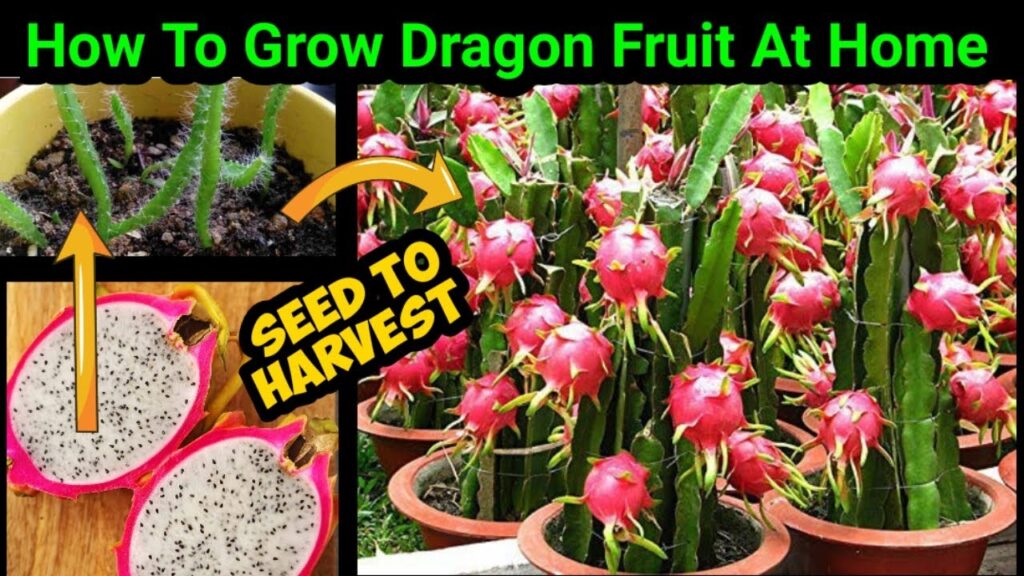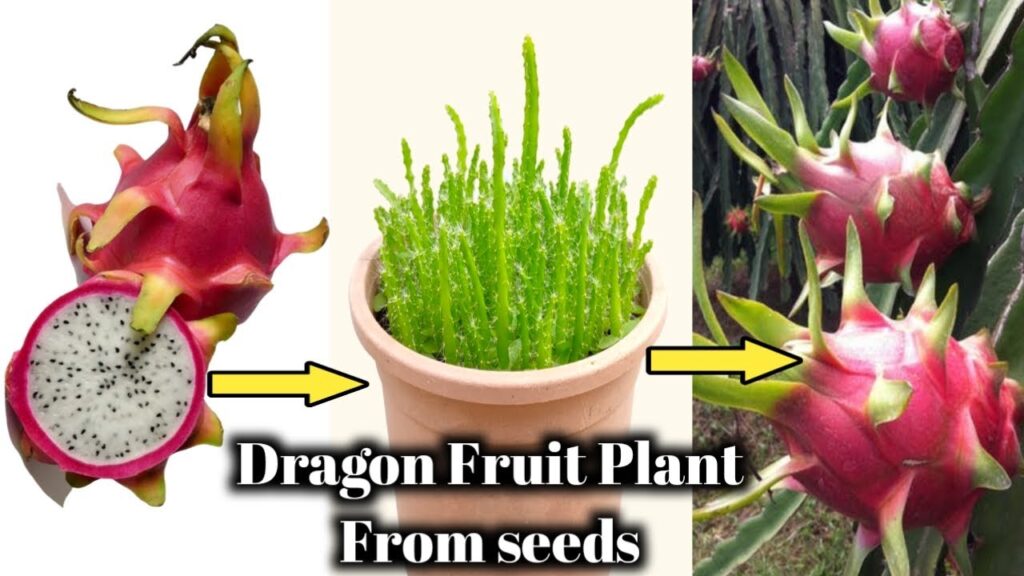Introduction
Embarking on the journey to grow dragon fruit at home is a captivating venture that promises not only a visually stunning addition to your garden but also the satisfaction of cultivating an exotic fruit with unique flavours. In this detailed guide, we will delve into the intricacies of dragon fruit cultivation, exploring the steps, tips, and uncommon terminology to ensure a successful and rewarding gardening experience.

Understanding the Enigma: Growing Dragon Fruit At Home
Before we dive into the cultivation process, let’s unravel the mysteries surrounding the captivating dragon fruit. Scientifically known as Hylocereus, this cactus species boasts distinctive, elongated stems, often referred to as “cladodes,” bearing aerial roots and captivatingly vivid, dragon-scale-like skin.
Choosing the Right Variety
Growing dragon fruit at home begins with the crucial decision of selecting the appropriate variety. The two most prevalent types are Hylocereus undatus (white-fleshed) and Hylocereus costaricensis (red-fleshed), each offering a unique aesthetic and taste profile. Make this choice wisely, considering your climate and personal preferences.
Creating the Optimal Habitat: Environmental Factors
Creating an environment that mimics the native habitat of dragon fruit is imperative for successful cultivation. Let’s break down the key elements:
- Sunlight: Dragon fruit thrives in full sunlight, demanding at least 6-8 hours of direct exposure daily. Ensure your chosen spot basks in the sun’s embrace.
- Soil: Opt for a well-draining cactus mix enriched with organic matter. Maintain a pH range between 6 and 7 to create a nurturing soil environment.
- Thermal Balance: Dragon fruit revels in warmth, thriving in temperatures between 65°F and 90°F. Shield your plants from frost, as they exhibit sensitivity to colder conditions.
- Hydration: Strike a balance in watering practices, ensuring consistent moisture without succumbing to waterlogged conditions, which can lead to detrimental root rot.
Propagation Prowess: From Seeds to Cuttings

Seeds
Growing dragon fruit from seeds is a patient dance with time, as the germination process unfolds gradually. This method, although rewarding, demands dedication and a keen eye for nurturing the nascent sprouts.
Cuttings’ Expedited
Opting for cuttings provides a more accelerated journey to a thriving dragon fruit plant. Select a healthy cutting, allowing it to dry for a day or two to minimise the risk of infection during the planting phase.
Planting
- Cutting Inception: Begin by choosing a robust, disease-free cutting, ensuring it is allowed to air-dry for a day or two.
- Strategic Planting: Bury the cutting about 2-3 inches deep in well-draining soil, fostering stability and encouraging robust root development.
- Structural Support: Given dragon fruit’s climbing nature, a sturdy support structure, such as a trellis or pergola, is paramount for optimal growth.
Tending to the Dragon: Essential Care Practices
Fertilization Flourish
While not voracious feeders, dragon fruit plants benefit from a balanced, slow-release fertilizer. Aim for an N-P-K ratio of 10-10-10, applying it every 6-8 weeks during the growing season to nourish your plant adequately.
Pruning Ballet
Engage in a regular pruning ballet to maintain a healthy and productive dragon fruit plant. Remove any damaged or diseased branches and encourage lateral growth by judiciously trimming the tip of the main stem.

Pests’ Watchtower
Vigilance against potential pests is key. While dragon fruit is generally hardy, keep an eye out for aphids, scale insects, and spider mites. Organic insecticidal soap can act as a gentle yet effective remedy.
Anticipation: From Blossoms to Fruits
As your dragon fruit plant matures, the anticipation builds for the spectacular blossoms and the eventual emergence of the delectable fruits.
- Nocturnal Bloom Extravaganza: Dragon fruit flowers unfurl their intricate beauty predominantly at night, withering away by morning. The fragrant blossoms set the stage for the imminent fruiting phase.
- Fruit Unveiling: Post-pollination, the vibrant fruits emerge, signifying the success of your cultivation efforts. The duration from flowering to harvest can span 30 to 50 days, depending on various factors.
Troubleshooting Challenges: Taming the Dragon’s Hurdles

Yellowing Leaves Enigma
If your dragon fruit’s leaves take on a yellow hue, it may signal overwatering or nutrient deficiencies. Adjust your watering routine and consider a balanced fertilizer to remedy the situation.
Lack of Blooms Dilemma
Insufficient sunlight or a surplus of nitrogen in the fertilizer may hinder blooming. Ensure your plant receives ample sunlight, and adjust your fertilization approach accordingly to encourage a flourishing display of blossoms.
Pest Conundrum
Act promptly against pests. Neem oil or insecticidal soap can be effective allies, ensuring minimal impact on your plant’s overall health.
Harvesting the Bounty: Savoring the Fruits of Success
As your dragon fruit reaches maturity, the moment of harvest approaches. Here’s a systematic guide:
- Color as a Compass: Observe the fruit’s color as a reliable indicator of ripeness. A vibrant hue signals readiness for harvest.
- Gentle Detachment: Gently twist the fruit from the stem. If it detaches effortlessly, it’s a clear sign that it’s ripe and ready for consumption.
- Post-Harvest Handling Wisdom: While dragon fruit is best enjoyed fresh, if you find yourself with an abundance, refrigeration can preserve its freshness for up to two weeks.
Conclusion
In the realm of home gardening, growing dragon fruit elevates the ordinary to the extraordinary. From selecting the right variety to nurturing the plant through its various stages, each step is a testament to the cultivator’s dedication. As your garden transforms into a haven for this mystical succulent, the fruits of your labour will be as rewarding as the vibrant dragon fruit itself. So, embrace this botanical odyssey, and may your home be graced with the enchanting allure of the dragon.
